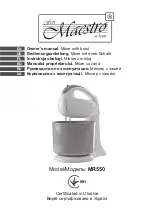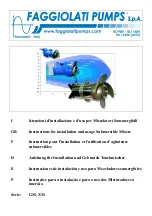
20
e)
If an Insert is used to connect an external unit such as a compressor, gate, EQ etc., use the
external processor's Bypass or Effect switch to A/B monitor the signals with and without the
effect, which should be level matched. (If no bypass switch is available, you will have to connect
and disconnect the unit until you achieve unity gain.)
f)
Set the PRO PFL push button to the 'UP' position and move to the next channel to be set up.
9.4
MIXER'S NORMAL SETTINGS
All the mixer panel settings should be set to the normal default condition before or after every mixing or
recording session. These are usually as follows: LEVEL (S 3) set to zero (-
∞
) BASS, MID and HIGH
equalizer controls (S 7, S 8, S 9) set flat (centre detent), STEREO IN LEVEL (S 4) and MONO IN GAIN
(S 5) Controls and AUX 1, AUX 2, AUX 3 Send sliders (S 10, S 11, S 12) etc. Many controls have a
natural initial setting. For EQ cut and boost this is unity, but some settings, such as PRE FADER or POST
FADER for the Aux Sends, will depend on the operating set up (e.g. Studio or Live Stage), or on the
particular sound engineer's preferences.
9.5
MULTI TRACK INITIALIZATION
Set up the multitrack recorder so that all tracks in 'record standby' condition have their inputs monitored
when the tape is not running. Place all tracks to be recorded into 'record standby' condition. Make sure
that the input levels to Track are adjusted correctly before starting the recording.
9.6 RECORDING
LEVELS
When making digital recordings, keep the recorder's peak meters below 0 dB. These generally read 0 dB
with some tolerance left, athough this is not always the case especially with samplers. The reason for this
tolerance is because digital distortion, unlike with analogue, is very sudden and the efect is really
unpleasant. To push your recording levels to the maximum (making full use of the 96 dB dynamic range
of 16-bit Digital equipment), you'll have to some calibration.
You can run a fixed frequency of around 1 kHz at 0 dB, which can be obtained from the C key 2 octaves
higher than middle C on a keyboard (1048 Hz), and use that as your DAT or ADAT reference level. But
your DAT or ADAT may be a lot under its maximum input limit. Probably a better system to establish how
hard you can push your recorder is to gradually increase the recording input level until the digital
distortion just sets in, then back off, maybe, 5 or 10 dB, and never go over that level. If your recorder is
implemented with a 'Peak Hold' facility, activate this to make sure that you do not.
When making analogue recordings, the tape recorder's VU meters should reach about +3 dB on basses,
but only about -10 dB for hi-hats. Although analogue distortion is similar to compression at low overload
levels (sometimes nice to have on basses), at the top end of the frequency range saturation sets in even
at low levels. Generally speaking, as well, standard VU meters are prone to read low over 1 kHz, owing
to their slow response time.
Typical VU meter readings should be about -10 dB for Hi-hats, compared to 0 dB for an average snare
drum, with +3 dB or over for a bass drum.
☞
Peak reading meters work almost independently of influence by frequency
.
Try to obtain a 0 dB
recording level for all types of signals.










































